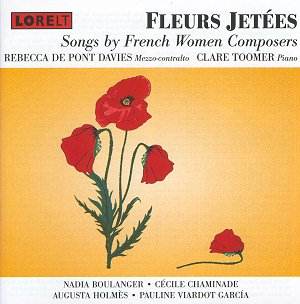What is a mezzo-soprano? (2)
The first
part of this survey consisted of some general comments and
a review of Magdalena Kozena’s CD of arias by Mozart, Gluck and Myslivicek.
I raised the question whether Kozena is likely to continue
labelling herself a mezzo-soprano for much longer and now move to the
opposite extreme, for Rebecca de Pont Davies classes herself as a "mezzo-contralto".
This is something I had not encountered before and I wish her curriculum
had found space to say what she really means. As it is I can only report
on the basis of my understanding of what I hear.
First of all, she is gifted with a voice which is gloriously
rich in timbre in the octave which starts from middle C. It is that
kind of voice which is sometimes described as "unwieldy" in
the sense that it speaks slowly. When we describe a voice as "speaking"
we refer to the time taken between attacking the note and the note’s
finding its natural vibrations. Since most of the songs here are slow
you can take one more or less at random and you will hear how there
is an appreciable time-lapse before each long note rings out in all
its glory. Whereas, with lighter voice-types, the voice "speaks"
almost immediately. The prevalence of slow and sultry songs is presumably
dictated by the fact that it is these which will show the singer to
her best advantage.
Taking this first octave as her base, she is able to
carry this rich sound right up to a G and even an occasional A. This
could be one justification for the "mezzo-contralto" since
a pure contralto is not normally expected to arrive quite so high. These
high notes do not sound strained but they do seem to carry a colossal
weight behind them. They express powerful emotions and I doubt that
de Pont Davies could float them celestially as Magdalena Kozena and
Cecilia Bartoli can.
She also shows, in Chaminade’s "Fleur jetée",
that she can go right down to a low G with minimal use of chest tones,
but she also exploits, to very exciting effect, her chest voice on the
notes around middle C downwards. This would normally be done by a mezzo-soprano
rather than a contralto and provides another justification for the "mezzo-contralto"
label. If you compare the beginning of Chaminade’s "Chanson slave",
where the use of chest-tones is quite blood-curdling, with the first
stanza of the same composer’s "Rêve d’un soir", where
notes just as low are sung in the "normal" voice, you will
get a very good demonstration of the difference between the two techniques.
Now, this type of voice may not appeal universally
(you may have read between the lines that I like it very much) but we
should certainly thank Ms de Pont Davies for a useful voice definition,
especially when so many mezzo-sopranos today seem almost real sopranos.
What you may find inescapable is that the degree of sultry languor heard
over the whole programme is a bit unvaried. This is particularly noticeable
in the Nadia Boulanger settings which are signally lacking in the economy
of utterance she expected from her pupils, and when she composes in
tandem with Raoul Pugno they seem to go on for ever! Certainly Chaminade’s
lighter touch brings heartfelt relief, and the more extrovert Viardot-Garcia
settings find the singer really letting her hair down at last. The Irish-born
Holmès also appears to best advantage when she shows her lighter
side – "Sérénade printanière" is a particularly
attractive piece. Whether these four composers really specialised in
Chausson-like steaminess or whether the choice was made on the basis
of the singer’s gravitation towards such pieces is raised by a comparison
with Anne Sofie von Otter’s recent
all-Chaminade CD (DG 471 331-2) which has no items in common with
those here and which presents a completely different aspect of the composer.
This disc will be reviewed as What is a mezzo-soprano? (3).
I hope I have made it adequately clear that Rebecca
de Pont Davies has something very specially her own to offer. Her voice
is a stunning instrument and, while it seems suitable for a limited
range of music, this CD is assuredly worth the attention of all those
who do not restrict their horizons to music they already know and performers
that are household names.
Christopher Howell

![]() Recorded in St. Paul’s
Church, New Southgate, London, no date, published 1996
Recorded in St. Paul’s
Church, New Southgate, London, no date, published 1996 ![]() LORELT LNT109 [62.25]
LORELT LNT109 [62.25]